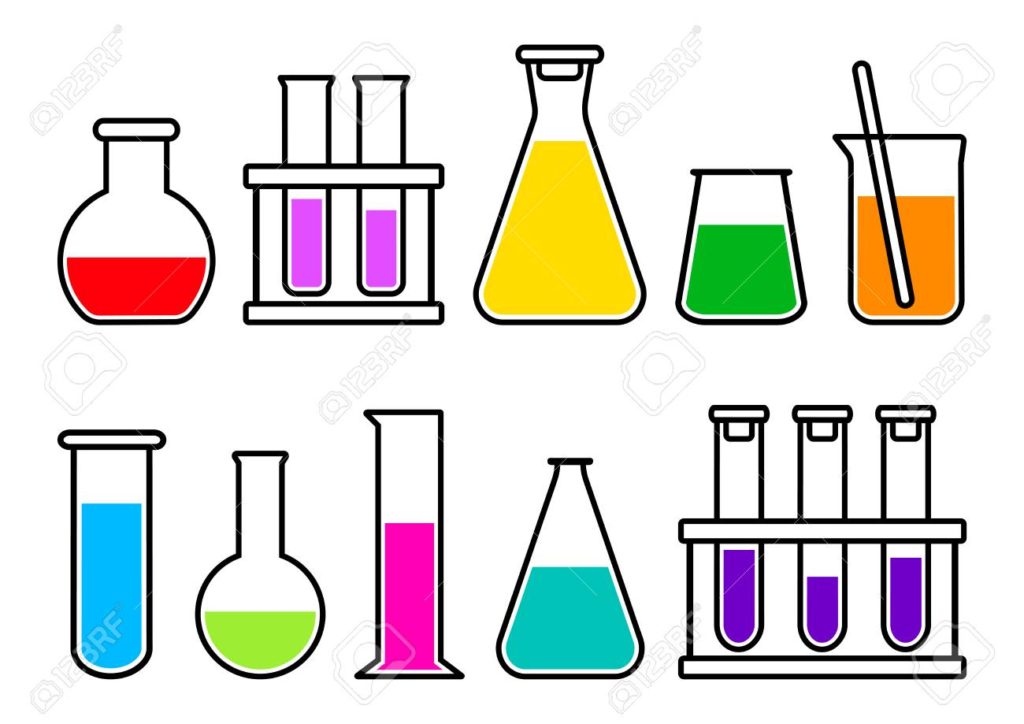The road to the laboratory is paved with fizz, slime, messy purple stuff, bad smells, and goo. “Do-it-yourself chemistry has always been the most potent recruiting tool science has to offer,” states an article in Wired magazine. Right on.
Table of Contents
All About Chemistry
| Also see The Periodic Table. | |
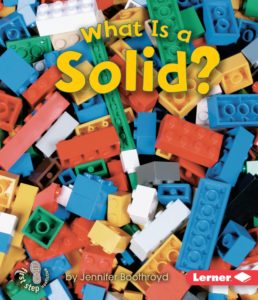 |
Jennifer Boothroyd’s What Is a Solid? (Lerner Classroom, 2007) is a photo-illustrated explanation for beginners, with simple experiments. Companion books are What Is a Liquid? and What Is a Gas? Basic definitions of crucial terms like solution and evaporation for ages 4-7. |
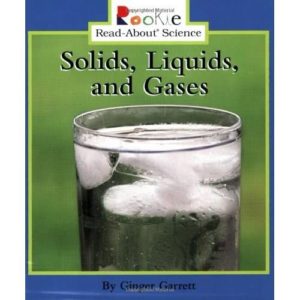 |
Ginger Garrett’s Solids, Liquids, and Gases (Children’s Press, 2005) is a simple introduction to the three states of matter, illustrated with color photographs. For ages 4-8. |
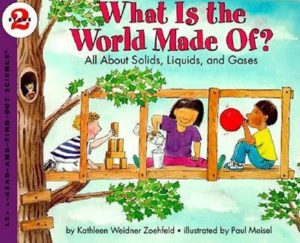 |
Kathleen Weidner Zoehfeld’s What Is the World Made of? All About Solids, Liquids, and Gases (HarperCollins, 1998) in the Let’s-Read-and-Find-Out Science series begins “Have you ever seen anyone walk through a wall? Did you ever drink a glass of blocks?” A friendly explanation of the three states of matter with a short appended list of activities. For ages 4-8. |
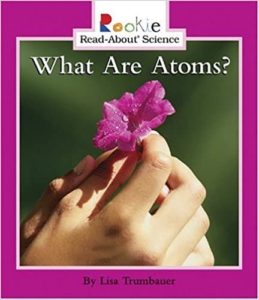 |
Lisa Trumbauer’s What Are Atoms? (Children’s Press, 2005) in the Rookie Read-About Science series is a simple large-print explanation for beginners, illustrated with color photos. For ages 5-8. Other chemistry-related books in this series are Don L. Curry’s What Is Matter? and What Is Mass?; Lisa Trumbauer’s What Is Volume?; and Joanne Barkan’s What Is Density? |
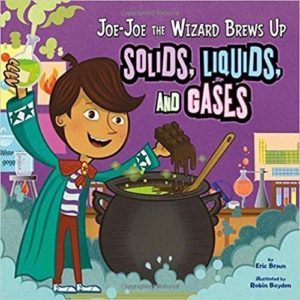 |
In Eric Braun’s Joe-Joe the Wizard Brews Up Solids, Liquids, and Gases (Picture Window Books, 2012), Joe-Joe, a student at Ms. Tickle’s Academy of Magic, is doing his best to change his homework into chocolate. Knowledgeable Ms. Tickle steps in to explain the three states of matter and how they change from one to another. With zany illustrations by Robin Boyden. For ages 5-8. |
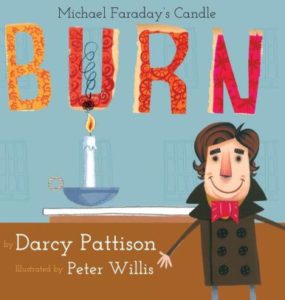 |
British scientist Michael Faraday was famed for his Christmas lectures for children – most famously for “The Chemical History of a Candle,” which explained just how a candle burned. Darcy Pattison’s Burn (Mims House, 2016) is a picture-book version of Faraday’s lecture for ages 6-9. |
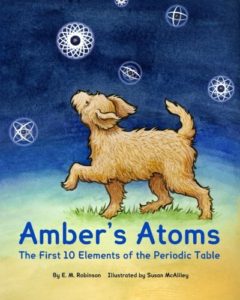 |
By E.M. Robinson, Amber’s Atoms (Design Friendly Press, 2016) is an introduction to the first ten elements of the Periodic Table. With a puppy. For ages 6-9. |
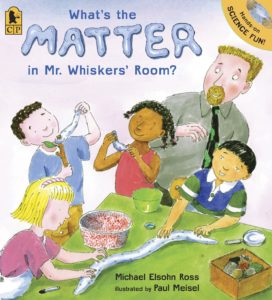 |
In Michael Elsohn Ross’s What’s the Matter in Mr. Whiskers’ Room? (Candlewick, 2007), Mr. Whiskers – the male counterpart to the Magic School Bus’s Ms. Frizzle – encourages his kids to explore matter through hands-on experiments. The kids make gloop and oobleck (recipes included), melt ice, weigh rocks, and make mud, all the while learning crucial facts about matter. For ages 5-10. |
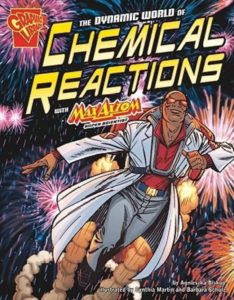 |
The Max Axiom, Super Scientist series (Capstone) is a collection of graphic novels starring Max Axiom, who wears a flowing lab coat and a pair of really remarkable glasses that act as both X-ray machine and microscope. Check out The Solid Truth about States of Matter with Max Axiom and The Dynamic World of Chemical Reactions with Max Axiom. For ages 7-10. |
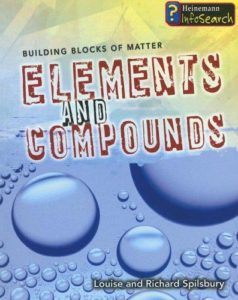 |
Titles in Richard Spilsbury’s Building Blocks of Matter series (Heineman, 2007) are Atoms and Molecules, Elements and Compounds, Mixtures and Solutions, and Chemical Reactions. Each has explanations and experiments, with catchy facts in “Did you know?” boxes. Illustrated with color photographs. For ages 8-11. |
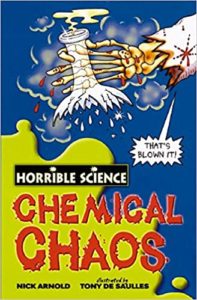 |
Nick Arnold’s Chemical Chaos (Scholastic, 2014) is one of the Horrible Science series, a collection of twenty books, among them Blood, Bones, and Body Bits, Evolve or Die, Microscopic Monsters, and Space, Stars, and Slimy Aliens. An appealingly awful introduction to chemistry for ages 8-12. |
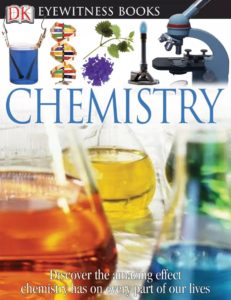 |
Ann Newmark’s Chemistry (Dorling Kindersley, 2005) in the Eyewitness series is a gorgeously illustrated overview in which each topic is covered in an intriguing double-page spread. Topics include, for example, Chemistry in the Ancient World, The Elements, Investigating Compounds, The Periodic Table, Chemical Reactions, Acids and Bases, Forming Salts, The Chemistry of Life, and The First Plastics. A lot of the information is conveyed in creative picture captions. For ages 8-12. |
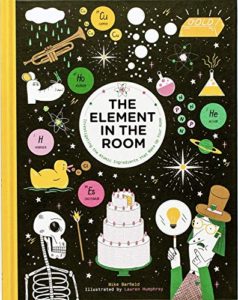 |
By Mike Barfield, The Element in the Room (Laurence King Publishing, 2018) is a guide to the atomic ingredients that make up everything around us, illustrated with catchy colorful graphics and appealing “Atomic Comics.” It’s aimed at younger readers – the recommended age is 7-11 – but the complex science is probably a little much for a seven-year-old. Try 9-13. |
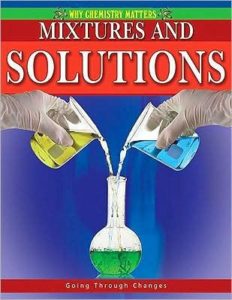 |
The Why Chemistry Matters series (Crabtree Publishing) is a collection of 32-page books, each covering a different chemistry concept in the context of everyday life. Sample titles are Atoms and Molecules and Mixtures and Solutions by Molly Aloian, and Elements and Compounds, Chemical Changes, Acids and Bases, and States of Matter by Lynette Brent. See Why Chemistry Matters for more details. For ages 10-14. |
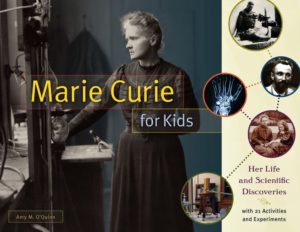 |
Amy M. O’Quinn’s Marie Curie for Kids (Chicago Review Press, 2016) covers Curie’s life and scientific discoveries, with period photos, sidebars, and 21 hands-on activities. For ages 9 and up. |
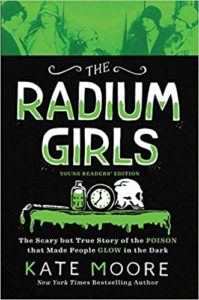 |
Kate Moore’s The Radium Girls (Sourcebooks Explore, 2020), the Young Readers edition of the adult book, is the fascinating – but scary – story of the young girls who worked painting radioactive watch dials. For ages 8-12. |
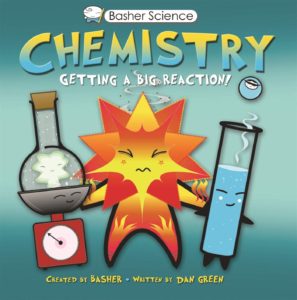 |
For real chemistry with a sense of humor, see Simon Basher and Dan Green’s 128-page Chemistry: Getting a Big Reaction (Kingfisher, 2010). The book is illustrated with great little cartoon characters and information is delivered in the first-person. In the “Basic States” chapter, for example, Liquid – a blue blobby character in a beret and sunglasses – says “Nothing much bothers me, man. Like an old-school beatnik, I’m easygoing and just go with the flow.” Memorable, clever, and thorough for ages 9-14. |
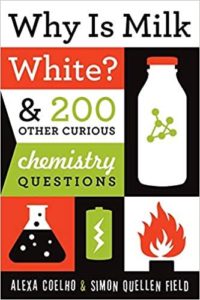 |
Chemist Simon Quellen Field and teenager Alexa Coelho are the authors of Why Is Milk White? & 200 Other Curious Chemistry Questions (Chicago Review Press, 2012), a fascinating compilation of good questions (Alexa) and chemistry-savvy answers (Simon). Questions are grouped into ten general categories, among them People and Animals, Plants, Household Chemistry, Things That Catch Fire or Go Bang,Things That Stink, and Color. Among the questions: “How does superglue work?” “How do we make different colored fireworks?” “Why do skunks smell bad?” “Why is water clear?” “What is the strongest kind of acid?” and “Can you really change lead into gold?” Included are a handful of better-than-ordinary experiments to try at home, among them “Smoking Hands” (yes, really), “Making Oxygen,” “Butane Balloon,” and “Hollow Pennies.” These are the sorts of science questions real kids ask. For ages 9 and up. |
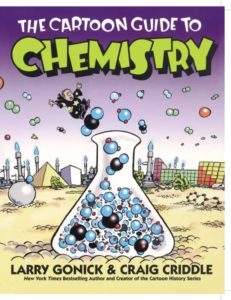 |
Larry Gonick’s Cartoon Guide to Chemistry (HarperResource, 2005) is serious chemistry presented through Gonick’s clever, funny, and knowledgeable little cartoons. The book is divided into twelve chapters, among them “Hidden Ingredients,” “Chemical Reactions,” “Acid Basics,” “Chemical Thermodynamics,” and “Organic Chemistry.” A good pick for the text-shy. For ages 13 and up. |
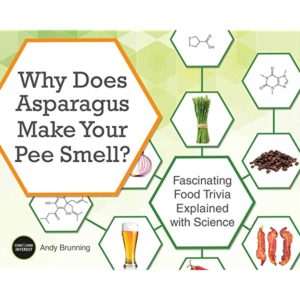 |
By Andy Brunning, Why Does Asparagus Make Your Pee Smell? (Ulysses Press, 2016) is a compendium of fascinating food facts, illustrated with great chemical graphics. The science behind why some people hate Brussels sprouts, why some mushrooms are poisonous, why onions make us cry, and much more. For teens and adults. |
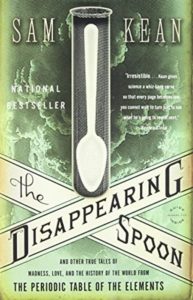 |
Sam Kean’s The Disappearing Spoon (Little, Brown, 2010) is a great chemical read, tying history, mythology, the arts, and a lot of fascinating anecdotes to the story of the Periodic Table of Elements. For teens and adults.
Also see the Young Readers edition, for ages 10 and up. |
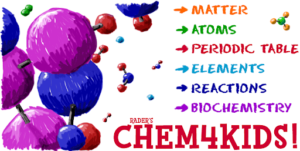 |
Chem4Kids is a nicely presented general overview of chemistry for kids, varioiusly covering matter, elements, atoms, chemical reactions, and biochemistry. Under “Activities,” there’s a long list of 10-question quizzes. |
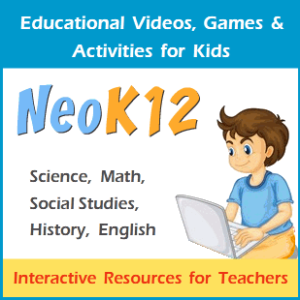 |
See the NeoK12 homepage for a long list of topics, for each of which there’s a large selection of short educational videos. Chemistry topics, for example, include Acids and Bases, Chemical Reactions, Organic Chemistry, Periodic Table, and Radioactivity. |
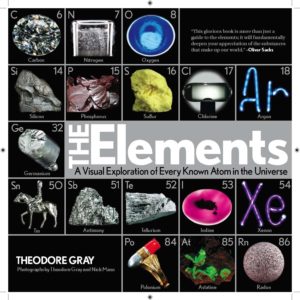 |
Theodore Gray’s Elements: A Visual Exploration of Every Known Atom in the Universe (Black Dog & Leventhal, 2011) is a gorgeously illustrated guide to the elements of the Periodic Table. A great source for all.
In the same format, also see Gray’s Molecules (2014), which covers everything from soap to stink bombs; and Reactions (2017), which – with wonderful color photos and a snappy text – introduces readers to a wide range of chemical reactions from the boring (watching paint dry) to the spectacular. |
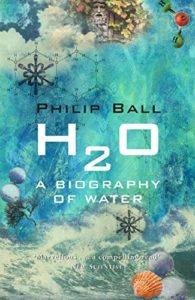 |
Philip Ball’s H2O: A Biography of Water (Weidenfeld & Nicolson, 2015) is the fascinating story of the world’s most familiar – and possibly most peculiar – compound. For teens and adults. |
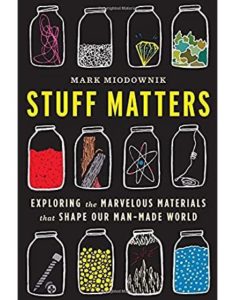 |
Mark Miodownik’s Stuff Matters (Mariner Books, 2015) is an engrossing survey of the science behind the materials that make up our world, from steel to glass, concrete, and chocolate. Why is glass see-through? And what really happens when you bend a paper clip? For teens and adults.
Also by Miodownik, see Liquid Rules (Houghton Mifflin Harcourt, 2019), the science of liquids. Think blood, ink, lava, and tea. |
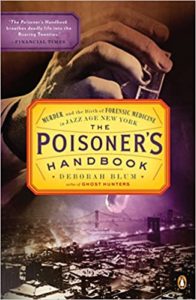 |
Fight crime with chemistry! Deborah Blum’s The Poisoner’s Handbook (Penguin, 2011), set in early 20th-century New York, is the story of how chemistry revolutionized forensics. An exciting read for teens and adults. Also see The Poisoner’s Handbook from PBS’s American Experience. |
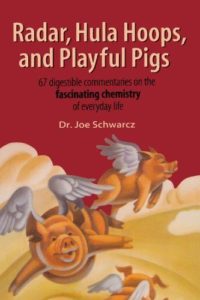 |
By (Dr.) Joe Schwartz, Radar, Hula Hoops, and Playful Pigs (Holt Paperbacks, 2001) is a collection of 67 “digestible commentaries on the fascinating chemistry of everyday life.” These are short (about four pages) essays on a wide array of chemistry-related topics: for example, readers learn about limelight, chocolate, champagne, tomato flavor, the forensics of blue jeans, and skunks. There are several chemistry-centered sequels along the same lines, among them The Genie in the Bottle, That’s the Way the Cookie Crumbles, and The Fly in the Ointment. For teenagers and adults. |
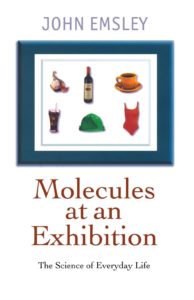 |
John Emsley’s Molecules at an Exhibition (Oxford University Press, 1999) is an eccentric overview of molecules in everyday life, among them oxalic acid (“Rhubarb Pie”), methyl mercaptan (“The Worse Smell in the World”), sulfur dioxide (“Acid Rain, Vintage Wine and White Potatoes”), and many more. For teenagers and adults. |
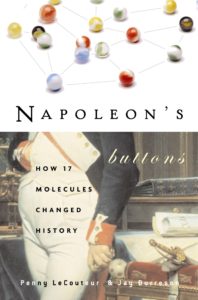 |
By Penny Le Couteur and Jay Burreson, Napoleon’s Buttons: How 17 Molecules Changed History (Jeremy P. Tarcher, 2004) is a thoroughly interesting read, with chapters covering ascorbic acid (and scurvy), glucose (and sweeteners), cellulose (and an exciting exploding apron), dyes, wonder drugs, rubber, “Molecules of Witchcraft,” and more. An introductory chapter covers (very nicely) chemical structures. For teenagers and adults. |
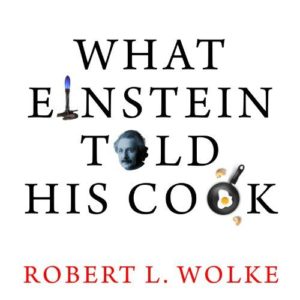 |
Robert L. Wolke’s What Einstein Told His Cook (W.W. Norton, 2002), subtitled “Kitchen Science Explained,” is a large collection of short interesting pieces on the chemistry of cooking. Find out why meat browns, why water boils, why chocolate melts in your mouth, and whether it’s possible to fry an egg on the sidewalk. For teens and adults.
Also see the sequel, What Einstein Told His Cook 2 (2005). |
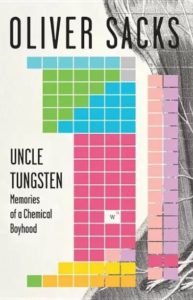 |
By neurologist Oliver Sacks, Uncle Tungsten: Memories of a Chemical Boyhood (Vintage, 2002) is a wonderful memoir of Sacks’s childhood in England during the 1930s and 40s, intertwined with his fascination with chemistry. (Chapter titles include “Stinks and Bangs,” “Mendeleev’s Garden,” and “Madame Curie’s Element.”) The Uncle Tungsten of the title is Sacks’s Uncle Dave – so-named because he manufactured lightbulbs with tungsten filaments – who also had a passion for chemistry. For teenagers and adults. |
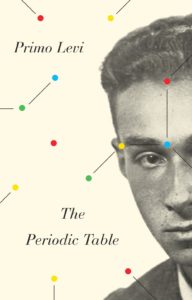 |
Primo Levi’s The Periodic Table (Schocken, 1995) – written by an Italian Jewish chemist, who spent World War II in Auschwitz – is a highly original memoir told through the elements of the Periodic Table. Each chapter title is the name of a different element, and in each, the element is used as a jumping-off point to discuss Levi’s experiences both as a chemist and as a man dealing with life in a Fascist state. For teenagers and adults. |
